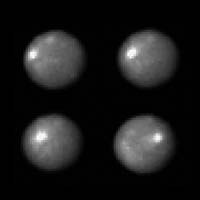
The four Hubble images of Ceres [left] were taken over a 2-hour and 20-minute span,
the time it takes the Texas-sized object to complete one quarter of a rotation.
One day in Ceres lasts 9 hours. The bright spot that appears in each image is a mystery.
September 7, 2005
Release No.: STScI-2005-27
Largest Asteroid May Be 'Mini Planet' with Water Ice:
Observations of Asteroid 1 Ceres, the largest known [in the main asteroid belt], have revealed that the object may be a "mini planet", and may contain large amounts of pure water ice beneath its surface.
The observations by NASA's Hubble Space Telescope also show that Ceres shares characteristics of the rocky terrestrial planets like Earth. Ceres' shape is almost round like Earth's, suggesting that the asteroid may have a "differentiated interior", with a rocky inner core and a thin, dusty outer crust.
"Ceres is an embryonic planet", said Lucy A. McFadden of the Department of Astronomy at the University of Maryland, College Park and a member of the team that made the observations. "Gravitational perturbations from Jupiter billions of years ago prevented Ceres from accreting more material to become a full-fledged planet".
The finding will appear Sept. 8 in a letter to the journal Nature. The paper is led by Peter C. Thomas of the Center for Radiophysics and Space Research at Cornell University in Ithaca, N.Y., and also includes project leader Joel William Parker of the Department of Space Studies at Southwest Research Institute in Boulder, Colorado.
Ceres is approximately 580 miles (930 kilometers) across, about the size of Texas. It resides with tens of thousands of other asteroids in the main asteroid belt. Located between Mars and Jupiter, the asteroid belt probably represents primitive pieces of the Solar System that never managed to accumulate into a genuine planet. Ceres comprises 25 percent of the asteroid belt's total mass. However, Pluto, our Solar System's smallest planet, is 14 times more massive than Ceres.
The astronomers used Hubble's Advanced Camera for Surveys to study Ceres for nine hours, the time it takes the asteroid to complete a rotation. Hubble snapped 267 images of Ceres. From those snapshots, the astronomers determined that the asteroid has a nearly round body. The diameter at its equator is wider than at its poles. Computer models show that a nearly round object like Ceres has a differentiated interior, with denser material at the core and lighter minerals near the surface. All terrestrial planets have differentiated interiors. Asteroids much smaller than Ceres have not been found to have such interiors.
The astronomers suspect that water ice may be buried under the asteroid's crust because the density of Ceres is less than that of the Earth's crust, and because the surface bears spectral evidence of water-bearing minerals. They estimate that if Ceres were composed of 25 percent water, it may have more water than all the fresh water on Earth. Ceres' water, unlike Earth's, would be in the form of water ice and located in the mantle, which wraps around the asteroid's solid core.
Besides being the largest asteroid [in the main asteroid belt], Ceres also was the first asteroid to be discovered. Sicilian astronomer Father Giuseppe Piazzi spotted the object in 1801. Piazzi was looking for suspected planets in the large gap between the orbits of Mars and Jupiter. As more such objects were found in the same region, they became known as "asteroids" or "minor planets".
A full-sized version of this image, captions, movies and other images are available in the World-Wide Web, at http://hubblesite.org/newscenter/newsdesk/archive/releases/2005/27/.
For more information from the Hubble Space Telescope,
you can link to the Space Telescope Science Institute Home Page.
Also see Dawn Mission (NASA-JPL Mission to Asteroids Ceres and Vesta in June 30 '07)
You can also link to ARVAL's Gallery, "Galileo to Jupiter", to see
Gaspra Rotation Sequence,
Highest-Resolution Image of Gaspra,
to read about and see Gaspra's surface features.
Or to
Ida Rotation Sequence,
Asteroid Ida,
Ida's Limb,
Ida and Dactyl, or to
Highest-Resolution Image of Dactyl,
to read about and see Ida's and Dactyl's surface features.
![]() ARVAL's Note:
ARVAL's Note:
Ceres Data:
Orbit Radius 413.715 MMKm (2.766 AU), Orbit Eccentricity 0.080, Orbit Inclination 10.587°,
Sideral Period 1,679.819 d (4.599 y), Equatorial Diameter 975 Km, Mass 9.5×1020 kg,
Density 2.08 g/cm3, Gravity 0.27 m/s2, Escape Velocity 0.51 km/s, Rotation Period 0.3781 d,
Axis Inclination ~4°.
Oppositions: August 12 '06, November 9 '07, ..., June 18 '10, 16 Sep. '11, 17 Dec. '12, 15 Apr. '14, 25 Jul. '15.
See 1 Ceres (Wikipedia),
JPL Small-Body Database Browser - 1 Ceres,
and Ceres: The Dwarf Planet.
See Dawn Mission
(Ion Propulsion, Asteroids Ceres and Vesta, from September 2007 to July 2015)
An asteroid bigger than Pluto has been discovered, provisionally called "2003 UB313" (Eris),
also with an approximately spherical shape, among the members of the Kuiper Belt.
See The discovery of 2003 UB313, Now Minor Planet Eris (the largest known dwarf planet, 27% larger than Pluto). Mike Brown, Professor of Planetary Astronomy, Division of Geological and Planetary Sciences, California Institute of Technology.
Also see The Minor Planets, and The Search for The Kuiper Belt in ARVAL.
![]() Updated: May 16 '07, April 16 '10
Updated: May 16 '07, April 16 '10
Best seen with MS Internet Explorer.
Back: ARVAL - Image Gallery
Messages: